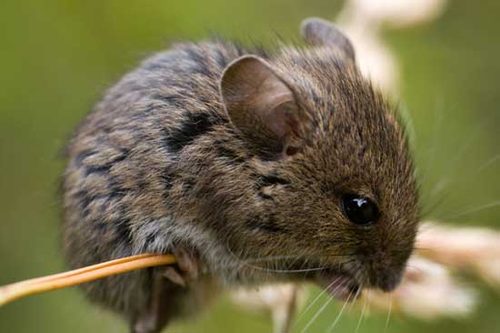
Last Friday, Diane Angell, Assistant Professor of biology at St. Olaf, stopped by the Arb office to give a talk about some little things that have been on her mind lately—furry little things.
Though popular culture holds these rodents in low regard, preferring to banish them to dark corners and fairy tales, in the context of prairies, the stories they show are both highly relevant and statistically significant (and okay, maybe even a little bit fairy tale-ish—after all, prairie voles are one of the few monogamous rodents on the earth!) Diane Angell has been tracking biodiversity in small mammals across restored and remnant prairies in the Northfield region for almost five years, working with student researchers to trap and record data about mice, shrews, and voles.
All of the remnant prairies Angell has surveyed are dominated by one type of rodent: deer mice. All the restored prairies she trapped on are dominated by meadow voles. Though she’s taken multiple samples in different restored and different remnant prairies in a range of locations, the prevalence of these two species is striking.
Angell’s thinking for such a sharp alignment between species and type of prairie is based on a deceptively simple concept: food. But the way that concept works is not the way she first predicted when she started trapping. Because most researchers point out that meadow voles love to eat warm season grasses (those that grow primarily mid to late summer), she expected to find a larger population of them on the restored prairie, where those kinds of grasses make up a majority of the plant life. Meadow voles are “like little cows,” Angell says. “They’re little grazers.” Similarly, she expected to find deer mice in the remnant prairies, where they can munch away on the larger numbers of cool season grasses (growing early in the year) and wildflowers.
The next step was to confirm that meadow voles are indeed foraging on those warm season grasses. Angell can figure out what these little guys are eating because she can analyze carbon isotopes in their fur, which she gathers out on the prairie by live-trapping them and then by giving them a bit of a haircut. Marking the fur also helps the researchers make sure they’re not catching the same rodents over and over again, and that they’re getting a reliably diverse sample of what is actually scurrying around the prairie.
What she found was very unexpected—the rodents don’t seem to be dividing into the two types of prairies based on which has a larger proportion of the plants they like to eat. Stable isotopes showed that despite the dominance of warm season grasses on restored prairies where there are lots of meadow voles, meadow voles were rarely foraging on them. While this seemed counterintuitive at first, it made Angell think about the relationship between prairie plants and their industrious little predators in a new way. Perhaps it was because meadow voles were mowing down cool season grasses, wildflowers, and their seeds on the restored prairies that created a distinctive drop in the number of these plant species seen in the restored prairies.
The Arboretum and other restoration efforts benefit from investigations like Angell’s, work that creates new ways to think about connecting different species and their environment. Maintaining some of the delicate balances within food chains is a major hurdle when it comes to restoring any ecosystem, including prairies. Being able to understand the relationships between plants and animals is an incredibly important part of being able to understand the overall environment, and it’s scientists like Angell that contribute to that goal.
Add a comment